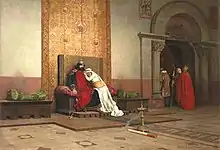Bell, book, and candle
The phrase "bell, book, and candle" refers to a Latin Christian method of excommunication by anathema, imposed on a person who had committed an exceptionally grievous sin. Evidently introduced by Pope Zachary around the middle of the 8th century,[1] the rite was once used by the Roman Catholic Church.
Ritual

The ceremony was described in the Pontificale Romanum until the time of the Second Vatican Council. Subsequent post-conciliar editions of the Pontificale omitted mention of any particular solemnities associated with excommunication.
The ceremony traditionally involved a bishop, with 12 priests bearing candles, and would solemnly be pronounced in some suitably conspicuous place. The bishop would then pronounce the formula of the anathema, which ends with the following words:
Idcirco eum cum universis complicibus, fautoribusque suis, judicio Dei omnipotentis Patris, et Filii, et Spiritus Sancti, et beati Petri principis Apostolorum, et omnium Sanctorum, necnon et mediocritatis nostrae auctoritate, et potestate ligandi et solvendi in coelo et in terra nobis divinitus collata, a pretiosi Corporis et Sanguinis Domini perceptione, et a societate omnium Christianorum separamus, et a liminibus sanctae matris Ecclesiae in coelo et in terra excludimus, et excommunicatum et anathematizatum esse decernimus; et damnatum cum diabolo, et angelis ejus, et omnibus reprobis in ignem aeternum judicamus; donec a diaboli laqueis resipiscat, et ad emendationem, et poenitentiam redeat, et Ecclesiae Dei, quam laesit, satisfaciat, tradentes eum satanae in interitum carnis, ut spiritus ejus salvus fiat in die judicii.[2]
In English:
Wherefore in the name of God the All-powerful, Father, Son, and Holy Ghost, of the Blessed Peter, Prince of the Apostles, and of all the saints, in virtue of the power which has been given us of binding and loosing in Heaven and on earth, we deprive him and all his accomplices and all his abettors of the Communion of the Body and Blood of Our Lord, we separate him from the society of all Christians, we exclude him from the bosom of our Holy Mother the Church in Heaven and on earth, we declare him excommunicated and anathematized and we judge him condemned to eternal fire with Satan and his angels and all the reprobate, so long as he will not burst the fetters of the demon, do penance and satisfy the Church; we deliver him to Satan to mortify his body, that his soul may be saved on the day of judgment.[1]
After this recitation the priests would respond: Fiat, fiat, fiat ("So be it! So be it! So be it!") The bishop would then ring a bell, close a holy book, and he and the assisting priests would snuff out their candles by dashing them to the ground. However, the rite of anathema as described in the Pontificale Romanum only prescribes that the candles be dashed to the ground. After the ritual, written notices would be sent to the neighbouring bishops and priests to report that the target had been anathematized and why, so that they and their constituents would hold no communication with the target.[2] The frightful pronouncements of the ritual were calculated so as to strike terror into the ones so excommunicated and bring them to repentance.
This form of excommunication was inflicted on Robert II of France by Pope Gregory V for his marriage to Bertha of Burgundy in the year 996, because Bertha was his cousin. He was later reconciled with the Church after negotiations with Gregory's successor Pope Silvester II.[3]
Cultural references
Shakespeare uses the phrase in King John. In Act 3, Philip Faulconbridge says "Bell, book, and candle shall not drive me back, When gold and silver becks me to come on."
The dramatic nature of the ritual has lent itself to frequent depictions in culture and media. It is referenced directly in the title of the 1958 film Bell, Book and Candle, based on the play by John Van Druten. Bell, Book & Candle is the name of an antiquities store in the West Village section of New York City.[4]
The ceremony was also dramatised and popularised in the 1964 film, Becket, in which Archbishop Thomas Becket (played by Richard Burton) excommunicates Lord Gilbert.[5][6]
In The Rolling Stones song “Winter” from their 1973 album Goats Head Soup is the lyric But I been burnin’ my bell, book and candle.
The store owned by the main character in The Good Witch film and television series is named Bell, Book, & Candle.
A similar ceremony is featured in the roguelike computer game NetHack.
The board game Betrayal at House on the Hill, where a group of adventurers explore a haunted house, features items the explorers can use. Three of which are the Bell, Book, and Candle, and when one owns the three simultaneously they confer a significant benefit to the player.
In the 1985 computer role playing game, Ultima IV: Quest of the Avatar, the Stranger must find the Bell of Courage, the Book of Truth, and the Candle of Love in order to enter the Abyss, the final dungeon of the game.
In the novel and television series Good Omens, the witch finder Newton Pulsifer is presented with a bell, a book, and a candle (along with other objects), before he goes off to face the witch Anathema Device.
References
- Joseph Gignac, "Anathema" in Catholic Encyclopedia (New York 1907)
- "Ordo Excommunicandi et Absolvendi". Liturgia Latina. Retrieved July 25, 2014.
- Lea, Henry C.: Studies in Church History: The Rise of the Temporal Power, pp. 339ff, Sampson Low, Son, & Marston, 1869.
- "Bell Book & Candle, 141 W. 10th St., New York, NY 10014 (nr. Waverly Pl. )". New York Magazine.
- "BECKET". SHU. Seton Hall University. Retrieved 7 May 2019.
- Anhalt, Edward. "Becket". Scripts. STANDS4 LLC. Retrieved 7 May 2019.
Further reading
- "Bell, book, and candle". Encyclopædia Britannica. 2005.
- Mabillard, Amanda (2005). "Shakespeare FAQs: Bell, book, and candle". About.com.
